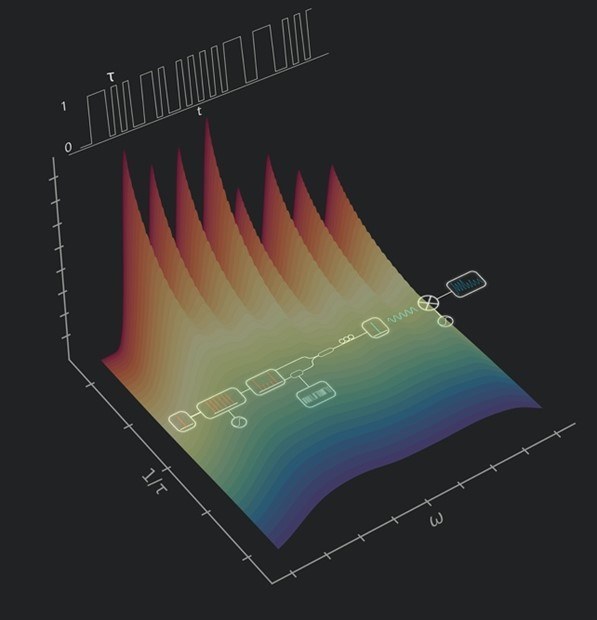
Research team at UCL and ETH demonstrate new technique for THz spectroscopy using components from the optical internet
A novel concept for extracting information from spectra where traditional post-processing procedures fail, dubbed ‘software-defined spectroscopy’, offers a fresh approach to high-resolution terahertz spectroscopy. The new method implements an ‘optical comb’ and combines it with a programmable modulator, all using components from the optical internet.
The terahertz (THz) spectral band, which sits between the infrared and microwave regions of the electromagnetic spectrum, provides a unique observation window for a broad range of fields, from astronomy and solid-state physics to medical imaging and material characterisation. Tapping this enormous potential, however, remains challenging, as the technologies needed for the generation, manipulation and detection of THz radiation are less developed than those for the adjacent frequency bands. This is true, in particular, with regard to systems for continuous-wave (CW) spectroscopy where the frequency is scanned across a given range, to be absorbed at characteristic points by the species under study.
A team led by Prof Alwyn Seeds of University College London and Prof Gabriel Aeppli of PSI, ETH Zurich and EPFL, supported by the UKRI-EPSRC HyperTerahertz Programme Grant including Connected Electronic and Photonic Systems Centre for Doctoral Training research student James Seddon, has developed a novel technique that boosts the capability of CW THz spectrometers by suitably tailoring the illumination radiation using software control. As they report in a paper published today in Optica, the team demonstrated that with this approach information about closely spaced peaks can be extracted that remains inaccessible when using conventional methods.
Bespoke illumination
Traditionally, spectroscopic information is obtained by fitting model parameters to the measured data. This is a versatile approach, but one that can introduce systematic errors or produce ambiguous results, especially for noisy data. To overcome such shortcomings, Seeds, Aeppli and colleagues now turn the tables and replace the line fitting in post-processing with modulating the spectral line shape of the THz radiation — using the same components that enable writing binary zeros and ones for transmission across the optical fibres forming the backbone of the Internet.
THz radiation is shaping up
The experimental cornerstone of the new method is a spectrometer that is continuously tunable in frequency and that delivers ultra-high resolution and spectral purity. Importantly, the THz source is based on photonics technology, exploiting elements and techniques that were initially introduced in the context of high-speed telecommunications. Now the team has harnessed this kit of readily available and relatively inexpensive optical-telecommunications components to synthesize THz signals with software-defined line shapes.
Programmable spectroscopy
This new capability of ‘programming the illumination’ offers a flexible means for generating THz radiation that can be tweaked until it matches the intrinsic spectral line shape of the sample. In doing so, more direct insight is obtained into the physical properties of the sample itself, compared to the traditional fitting approach. In order to demonstrate that advantage, the researchers studied the rare-earth salt LiYF4:Ho3+ — a material of great interest for quantum technologies — and found that in this system the intrinsic line shape is caused by inhomogeneous broadening, thereby ruling out state life time as a significant contributor to the absorption linewidth.
Given that the novel approach enables the construction of essentially arbitrary illumination spectra, the team expects that their newly established software-defined spectroscopy technique might become a general tool for the optimal characterization of lines in THz spectra — thus helping to more fully explore the wealth of spectroscopic information residing in this frequency band.
Title: Ultra-high-resolution software-defined photonic terahertz spectroscopy
Authors: R. Hermans, J. Seddon, L. Ponnampalam, H. Shams, A. Seeds, G. Aeppli
Publication: Optica, Vol. 7, Issue 10, 1445–1455 (2020).
DOI: 10.1364/OPTICA.397506
Contacts: Prof. Dr. Gabriel Aeppli, Paul Scherrer Institut, T: +41 56 310 4232, E: gabriel.aeppli@psi.ch
Prof. Dr. Alwyn Seeds, UCL, T: +44 7780 484193, E: a.seeds@ucl.ac.uk
Grant information:
UKRI/EPSRC HyperTerahertz - High precision terahertz spectroscopy and microscopy (EP/P021859/1)
UKRI/EPSRC Centre for Doctoral Training in Connected Electronic and Photonic Systems (CEPS) (EP/S022139/1)
